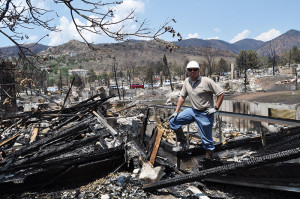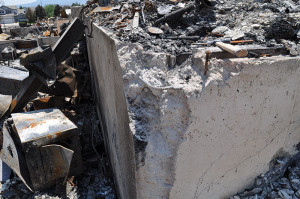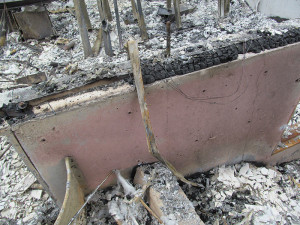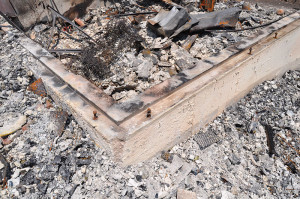El Paso County, Colorado is located approximately 70 miles south of Denver, has a land area of 2,127 square miles, and had a 2012 population of approximately 645,000 (representing 12 percent of the population of Colorado). Although the majority of the El Paso County population is concentrated in Colorado Springs and along the Interstate 25 corridor, densely-populated areas also exist at the east edge of the Pike National Forest where the Rocky Mountain Foothills meet the Front Range. With only a few exceptions, all of the structures built within El Paso County are within the jurisdiction of the Pikes Peak Regional Building Department.
On Saturday, June 23, 2012, a fire ignited in Waldo Canyon inside the Pike National Forest, approximately four miles northwest of Colorado Springs. The fire was given the namesake of its origin canyon, and burned eastward engulfing approximately 18,250 acres of land and destroying 346 homes. Two fatalities were reported. The wildfire was fully contained by July 10, 2012. At last report, the insurance claims for the wildfire exceeded $450 million.

Figure 1. View showing the widespread damage that occurred though this suburban neighborhood following the Waldo Canyon fire.
The Black Forest community in El Paso County is known for wide-spread moderately-dense Ponderosa Pine trees. The Black Forest area is located along the north edge of El Paso County, northeast of Colorado Springs. Structures built in the Black Forest community were mostly single family homes situated on ½- to 4-acre lots. On Tuesday, June 11, 2013, a fire started near the east edge of the Black Forest community and began to burn eastward. The Black Forest fire burned approximately 15,500 acres, destroyed 511 homes, and damaged 28 other structures. Two fatalities were reported. The Black Forest fire was fully contained by June 20, 2013. At last report, the insurance claims for the wildfire exceeded $295 million.
In response to the Waldo Canyon fire, the Pikes Peak Regional Building Department developed four scenarios to assist those who lost or experienced damage to their home. The four scenarios were as follows:
- Use of existing foundation, same house: “If Regional Building has the original plans, the only document required will be a letter from a licensed engineer stating that existing foundation is acceptable for rebuild. RBD will issue, at a minimum fee, a demolition permit for removal of fire debris. This permit is required to monitor removal activity and be sure fall protection is installed around the open foundation as required by code (2011 PPRBC). The single family dwelling shell can be constructed according to the plans on file with the issuance of a new remodel permit (434)… The interior finish portion of the house may not be required to meet all current structural or design criteria of the 2009 IRC, but will be required to meet all life/safety requirements and other design provisions that benefit the owner such as, but not limited to, State Electrical Code, smoke and CO detectors, energy conservation, etc.”
- Non-use of existing foundation, same house: “If Regional Building has the original plans, the documentation required will be a letter from a licensed engineer stating that foundation is not safe for rebuild and submittal of a new foundation plan for review/approval. RBD will issue a wrecking permit at a minimum fee for total removal of foundation and all fire debris. This permit is required to monitor removal activity and to be sure the foundation excavation is backfilled or protected according to code (2011 PPRBC)… The construction of the foundation must comply with all applicable provisions of the 2009 IRC. Inspections may be made by the engineer of record. The remaining portion of the structure located above the foundation may be constructed as outlined in # 1 above.”
- Building new home (different from original) at existing location: “Process will be the same as any new single family dwelling plan/permit submittal currently in place… One set of plans, including engineered foundation, site plan, all construction docs and duct design components to comply with 2009 IRC.”
- Repair of existing structure due to fire damage: “Process will be the same as any remodel for an existing residential structure.”
Scenarios 1 and 2 above required a licensed engineer to evaluate the remaining foundation to confirm it could be reused or to determine it was damaged to an extent that required replacement. Scenario 3, construction of an entirely new and different home, required the involvement of a licensed engineer to develop the new foundation plans, since El Paso County is an area known to contain expansive soils. Lastly, Scenario 4 typically required the involvement of a licensed engineer to evaluate the extent of the fire damage to the structure, and to develop reconstruction plans that could be submitted to the building department for the normal permitting/structural repair process. The guidelines for evaluation and repair of structures developed by the Pikes Peak Regional Building Department following the Black Forest fire were similar to those outlined above.
Structural engineers are frequently hired after disasters to evaluate the damage. As it pertains to both the Waldo Canyon and Black Forest wildfire events, insurance companies, owners, and contractors sought help from the Colorado engineering community to evaluate numerous structures to determine the extent of the damage. Specifically, most of the assigned tasks were to evaluate the remaining portions of the masonry and concrete foundations to determine whether the foundations could be reused.
Over a decade ago, the author of this article would typically obtain concrete cores of a damaged foundation, then submit these samples to a third party testing agency to conduct a chemical analysis, compressive strength tests, and a microscopic/petrographic analysis. Testing like that would often take four to six weeks and could cost $3,500 to $6,000, depending upon ease of site access and the number of cores to be extracted and evaluated. The results of the laboratory examinations were beneficial; however, after years of evaluating damaged concrete and CMU, the author was able to develop methods for quickly and economically evaluating concrete slabs and foundations for fire/heat damage. The rapid methods for evaluation were useful following the Waldo Canyon and Black Forest Fires, and helped property owners achieve faster resolution with less expense.
Evaluation
The four methods used to rapidly evaluate a concrete or concrete masonry unit (CMU) foundation for heat damage included the following:
Visual
A visual assessment is conducted to review the foundation for patterns of scorch marks, heat exposure, cracks, a change in color, surface spalls, and/or leaning/tilting of the walls. Tilting and leaning may not be due to heat damage, but can occur from the loss of diaphragm support after a structure is consumed by a fire. Wall tilts/leans, as well as cracks, may have pre-existed the fire event or may have been induced by the fire. Regardless of cause, cracks and leaning walls should be considered by the structural engineer in determining whether a foundation is reusable for construction.
Typically, normal concrete is not significantly altered or damaged below a temperature of 500 degrees Fahrenheit; however, rapid heating of the concrete can cause pore water to rapidly boil, which can cause surface spalls. Surface spalls can also result from sudden cooling/contraction after being sprayed by a fire fighter’s hose. Spalled areas should be carefully examined to determine whether they are a sign of widespread heat damage or an isolated occurrence that could be addressed with a targeted repair patch.
The color of the concrete paste should also be reviewed since a color change may indicate exposure to temperatures of greater than 550 degrees Fahrenheit. Concrete exposed to temperatures greater than approximately 570 degrees often turns a shade of pink, associated with chemical changes of the iron-containing compounds in the aggregates and paste matrix. At much higher temperatures, which are not commonly encountered during typical structure fires, the concrete can turn back to a light gray and then eventually to a yellowish-brown color. Concrete that has turned pink is damaged and should be replaced.
Smoke stains and scorch marks serve as a good indication of areas that were exposed to high heat when comparing to areas exposed to less heat, indicating further evaluation by methods 2 and 4 outlined below.
Audible/Sound Changes
A sounding hammer, typically a framing hammer with a hardened steel handle, can be used at various exposed surfaces to strike the surface and listen for subtle sounds in how the hammer rings. In general, healthy, undamaged concrete will cause a hammer to have a high-frequency ringing sound when struck. Concrete that has a consistent dull/thud or soft noise can indicate damaged or poor-quality concrete.
Fracture Mechanics
Healthy, undamaged concrete will typically fracture in a plane through the aggregate. In heat-damaged concrete, the paste matrix is often much weaker than the aggregates; therefore, the fracture plane will break around the aggregate pieces. In order to facilitate an evaluation of the fracture mechanics, the edge of the concrete can be struck with a framing hammer. Undamaged concrete will typically be very difficult to break, which may be an indication there is no damage. By comparison, heat-damaged concrete will crumble away with a few rigorous hits. Once broken, an experienced engineer can get a feel for the quality of the concrete and gain access to a fracture face for closer examination. Severely damaged concrete will unreservedly fall apart with a few arduous blows of a modest-sized hammer, often exposing the rebar and a paste matrix that has a chalky consistency.
A review of the distress in Figures 2 and 3 shows the effect of four to six hammer strikes on an area of heat-damaged concrete. Healthy, undamaged concrete would have likely required the better part of a day to accomplish the same damage using the same hammer.

Figures 2 and 3. Views showing how heat-damaged concrete exhibits low strength and crumbles easily when struck four to six times with a hammer. The rebar is exposed, and the fractures are through the paste, not the aggregate. Without conducting any further testing, this foundation is considered not suitable to be re-used in reconstruction of the structure.
Relative Concrete Strength
A Schmidt hammer, also known as a rebound hammer or a Swiss hammer, is a calibrated device that is used to measure the elastic properties or surface strength of the concrete. Although the results of the Schmidt hammer can be used to determine an approximate concrete compressive strength through use of empirical tables, the original as-built design compressive strength is often not known and therefore is of minimal benefit.
As with nearly all of the aforementioned evaluation methods, especially the Schmidt hammer evaluation, more meaningful data is obtained by a comparison of test results from at least four areas of the foundation. One way to do this is to conduct a Schmidt hammer test below grade at an excavated surface (where it was protected from heat by the soil) or at a lower inside foundation corner to obtain a baseline value for areas that were exposed to minimal/less heat. If areas of the foundation that were obviously exposed to high heat exhibit a 20 percent or more decrease in concrete strength compared to areas that were not exposed to heat, those results should be reported to the client and considered in the analysis of whether to reuse the foundation. The homes consumed in the Colorado wildfire events typically exhibited a concrete compressive strength of less than 2000 psi and a 30 to 50 percent reduction in strength compared to areas generally protected from exposure to heat.
In the event 50 percent or more of the foundation system exhibits damage, the entire foundation is typically removed and replaced. However, on occasion, an owner may want to preserve as much of the foundation as possible. This scenario may present itself in the case of historical buildings or an owner with minimal insurance coverage. In that event, additional evaluation, which would likely include laboratory analysis and/or non-destructive location of the embedded rebar, may be necessary to determine if the structure is safe to support the anticipated loads and what repairs are needed to fortify deficient areas. It is beyond the scope of this article to discuss those types of repairs.

Figure 4. View showing the characteristic pink hue of heat-damaged concrete. The signature pink color is a strong indicator the concrete is severely damage and cannot be re-used for reconstruction.
Conclusion
Ultimately, each client involved with the wildfire events was seeking clarification and information as to whether their foundation was undamaged, could be repaired, or required replacement. Since the Waldo Canyon and Black Forest wildfires were historical firsts in Colorado in terms of damage magnitude, minimal guidance was available from the local building department. However, a pattern quickly emerged that, where the structures had burned without any effort to extinguish the fire or control the temperatures, the sustained exposure to high heat was ultimately deleterious to the concrete and masonry, requiring complete foundation replacement.
It was this author’s experience that photographs taken before and after striking the concrete foundation with a hammer provided the most benefit to clients who had severely damaged foundations. Photographs showing the concrete could be dislodged to expose the rebar with two to six hits with a framing hammer quickly convinced homeowners who may have wanted to preserve/reuse their foundation to choose otherwise. Additional documentation, including the visual assessment, Schmidt hammer tests, and sounding hammer reports, helped augment and convey the extent of the damage. Using the aforementioned methods, engineering documentation regarding the extent of foundation damage was provided to the clients involved in less than a week.
It should be noted that structure fires are typically extinguished by firefighting professionals before the concrete is heated to an extent that it becomes damaged. Where structure fires are rapidly extinguished, the aforementioned evaluation methods can help determine whether a foundation is safe to be reused in the repair of a structure. These evaluation tests for heat damage to concrete can help determine a “go” or “no go” rapid evaluation for fire-damaged foundations. Specifically, it can quickly categorize the concrete as positively undamaged, positively damaged, or questionable requiring a further detailed analysis. Test results at buildings where these methods yield mixed, inconclusive, or borderline results should be further evaluated by laboratory analysis.▪

